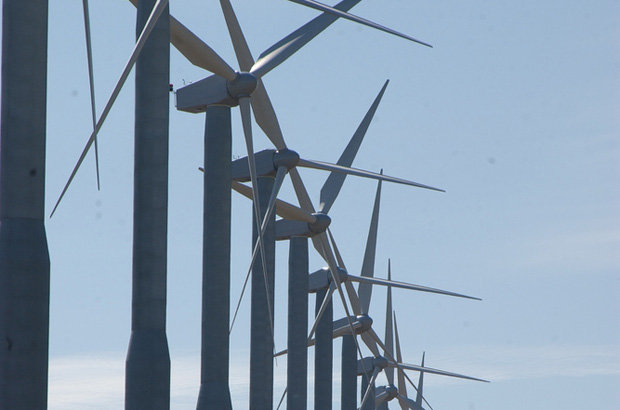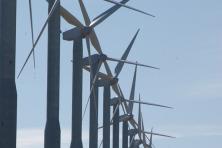On March 11, 2016 Oregon Governor Kate Brown signed landmark legislation to transition from coal to clean, renewable energy. The Oregon Clean Electricity, Coal Transition Act (SB 1547B) will remove coal from Oregon’s electricity by 2030 and double the state’s Renewable Portfolio Standard to 50% by 2040.1 This legislation is a critical piece of Oregon’s strategy to achieve a 75% reduction in greenhouse gases by mid-century that will transform Oregon’s electricity sector and deliver significant net reductions in greenhouse gas pollution. .
Oregon’s Greenhouse Gas Emissions at a Glance:
In 2007, the Oregon legislature passed ambitious climate change goals for Oregon: to arrest emissions growth by 2010; to reduce greenhouse gasses by 10% below 1990 levels by 2020; and to reduce greenhouse gas levels by 75% below 1990 levels by 2050. The good news is that Oregon’s greenhouse gas emissions peaked in 1999 and have been declining ever since. The bad news is that Oregon’s greenhouse gas levels are not falling fast enough to reach the 2020 and 2050 emissions targets.
Coal plant emissions alone account for 25% of Oregon’s total emissions,2 which were nearly 60 million metric tons in 2014. The electricity sector contributes 30% of those emissions because Oregon’s electricity mix is still heavily dependent on fossil fuels. In fact, coal powers one-third of the electricity for all Oregon homes and businesses and for Pacific Power customers, two-thirds of the electricity served is coal-generated. In order to meet its climate change goals, Oregon must remove the coal from its electricity mix.
Oregon receives its coal power from both in-state and out-of-state facilities. PGE’s Boardman facility is the only coal plant located in Oregon and it is scheduled to close by 2020. PGE, however, also imports coal power from Montana and Pacific Power imports 65% of its power from over twenty out-of-state coal plants located throughout the west. Together, Pacific Power and PGE produce 70% of Oregon’s electricity. PGE’s and Pacific Power’s reliance on out-of-state coal power prevents Oregon from achieving its greenhouse gas reduction goals.
Removing coal from Oregon’s electricity mix doesn’t go far enough. Oregon also needs higher efficiency and renewable electricity standards to ensure that coal power is replaced with clean energy. At present, PGE and Pacific Power plan to replace retiring coal plants with new fossil gas-fired generation. Under business-as-usual, historically low gas prices would drive investment toward fossil gas rather than renewables like wind and solar. Fossil gas at the point of combustion produces less carbon pollution than coal. But electric loads in Oregon are growing, due to an influx of new people and new industries. Locking in new 30-40 year investments in gas generation will assure that Oregon’s emissions plateau rather than decline. This is why the Oregon Clean Electricity and Coal Transition Act doubles the state’s renewable portfolio standard.
The Impacts of Oregon’s Clean Electricity Coal Transition Bill:
The Oregon Clean Electricity, Coal Transition Act reduces emissions by removing coal from Oregon’s electricity supply by 2030 and requiring PGE and Pacific Power to achieve at least 50% of their electricity from non-hydropower renewable resources such as wind and solar by 2040. The renewable energy requirement stair steps up; utilities will have to reach 27% renewable power by 2025; 35% by 2030; 40% by 2035; and 50% by 2040. The existing renewable portfolio standard in Oregon requires 25% renewable energy by 2025. Passage of this act means that Oregon now has one of the highest renewable portfolio standards in the country.
Over the next two-decades, both PGE and Pacific Power plan to invest in new power generation to service a growing load in Oregon. The new, higher renewable energy requirements should redirect planned investments in baseload fossil gas toward investments in clean energy, because it would be uneconomical for the utilities to invest in both. Gas may still have a role to play in the energy mix, but as an integrating resource alongside wind and solar, not as a source of baseload power. Passage of this Act is especially timely; PGE will soon need to decide how to replace the Boardman plant in 2020. Some combination of wind, solar, and efficiency will now likely replace the coal power from Boardman. The same is true for coal retirements and new generating needs facing Pacific Power. The removal of coal from Oregon’s energy mix and the displacement of baseload gas with clean energy results in significant net emissions reductions.
The Act will bring significant carbon pollution reduction with minimal impact on ratepayers. Three separate analyses of the greenhouse gas reductions of Oregon’s Clean Electricity, Coal Transition Act confirm the Act’s carbon reduction benefits. The state Global Warming Commission finds that the Act will cut emissions from the electric sector in half by 2030 compared to a business-as-usual baseline, resulting in a 15% reduction in Oregon’s total emissions. In a hearing before the Oregon Public Utility Commission on January 29, 2016, PGE and Pacific Power projected net greenhouse gas reductions of over 30 million metric tons between 2025 and 2040. This is equivalent to removing 6.4 million cars from the road each year. By 2040, annual reductions will exceed 4 million metric tons. An independent analysis commissioned by Renewable Northwest produced comparable estimates and reached the same conclusion. These different analyses also determined that the rate impacts will be minimal. At most, rates may rise by 1-1.5% percent in the near term. Hence, the Act is expected to save ratepayers money over the long term.
These findings are independent of what happens to the coal power that is used to service Oregon customers. Oregon cannot force coal plants to close in other states, but by refusing to receive that coal power, it adds to mounting pressures on these facilities to ramp down and close. Pacific Power’s coal plants allocate 25% of their current load to Oregon – a significant amount. This Act requires those facilities to find new markets for that coal power, reduce generation, or close. Faced with rising regulatory costs from the federal Clean Power Plan, and other state and regional clean air requirements, the future for these coal facilities is increasingly bleak. Oregon is contributing to a national effort to shutter coal fired power plants.
Lastly, the Oregon Clean Electricity, Coal Transition Act also takes important steps toward electrifying the transportation sector in Oregon. Just as coal contributes 25% of Oregon’s emissions, so too do cars and light vehicles. Switching from gasoline and diesel fuel to electricity is a key strategy for meeting Oregon’s climate change goals when it comes to the transportation sector. The Act encourages this by enabling Pacific Power and PGE to make prudent investments in charging stations and related electric vehicle infrastructure in their service territories. This is a significant climate benefit of the Oregon Clean Electricity, Coal Transition Act.
[1] The one potential exception is a small amount of coal power from PGE’s ownership share of Colstrip, which would be out of the Oregon mix no later than 2035.
[2] Oregon greenhouse gas emissions data from the Oregon Global Warming Commission Biennial Report for the Legislature 2015.




